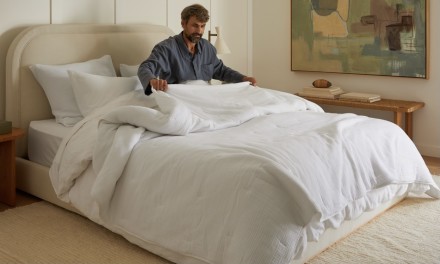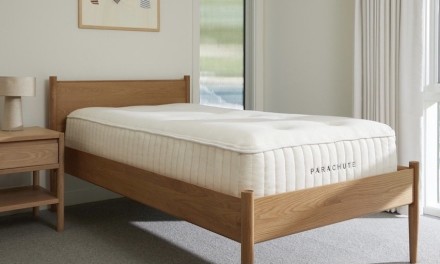High-quality bed linens are definitely worth the investment, and many people view thread count as an indicator of quality. But what does thread count mean exactly, and what is a good thread count for sheets?
Ahead, answers to these questions and tips on what to look for when buying sheets.
What Is Thread Count?
Thread count is the number of threads or yarns in a square inch of fabric. A high thread count generally indicates that the threads are finer (thinner), meaning more can fit into a single square inch. A higher number is sometimes associated with better materials, but this isn't necessarily the case.
So — what thread count is good? The answer isn’t as simple as looking for a higher number. There are many factors to consider when buying sheets. We’ll cover them below.
What Is a Good Thread Count for Sheets?
A good thread count for sheets is usually somewhere between 200 and 600. This varies depending on the material, as certain fabrics have finer or thicker fibers. For instance, the raw fibers of linen are naturally thicker, so the thread count for this textile is substantially lower than for cotton.
Why Thread Count Isn't Everything
But what is the best thread count for sheets? The answer isn't cut-and-dried.
For one thing, the highest thread counts of 1,000 or above are usually synthetic fabrics, such as microfiber, which aren't as breathable as natural alternatives. Also, there aren't any regulations for what brands can claim in their product descriptions, so a high number may essentially be meaningless.
Further, some of the highest-quality materials like linen have inherently lower counts simply due to the thickness of the raw plant fibers.
For more about why thread count isn't the be-all and end-all for sheets, see our blog, The Truth About Thread Count.
What Is Thread Count?
Thread count is the number of threads or yarns in a square inch of fabric. A high thread count generally indicates that the threads are finer (thinner), meaning more can fit into a single square inch. A higher number is sometimes associated with better materials, but this isn't necessarily the case.
So — what thread count is good? The answer isn’t as simple as looking for a higher number. There are many factors to consider when buying sheets. We’ll cover them below.
What Is a Good Thread Count for Sheets?
A good thread count for sheets is usually somewhere between 200 and 600. This varies depending on the material, as certain fabrics have finer or thicker fibers. For instance, the raw fibers of linen are naturally thicker, so the thread count for this textile is substantially lower than for cotton.
Why Thread Count Isn't Everything
But what is the best thread count for sheets? The answer isn't cut-and-dried.
For one thing, the highest thread counts of 1,000 or above are usually synthetic fabrics, such as microfiber, which aren't as breathable as natural alternatives. Also, there aren't any regulations for what brands can claim in their product descriptions, so a high number may essentially be meaningless.
Further, some of the highest-quality materials like linen have inherently lower counts simply due to the thickness of the raw plant fibers.
For more about why thread count isn't the be-all and end-all for sheets, see our blog, The Truth About Thread Count.
What to Consider When Buying Sheets
What to Consider When Buying Sheets
While many people see a high thread count for sheets as an indicator of high-quality bedding, this notion is somewhat outdated. That's why fewer and fewer bedding companies mention thread count in their product descriptions and on their packaging today.
So how do you know if you're buying top-tier bed linens? Pay attention to the material, weave, durability and certifications.
Material and Weave
The raw fibers used to make sheets are generally a better indicator of quality, softness, breathability and overall feel than thread count. The best materials include linen and 100% cotton, whether it's percale, sateen, brushed cotton or organic cotton.
Here's what to know about each fabric.
Linen
Linen is considered one of the best — not the best — bedding textiles available, which is why it's often priced slightly higher than cotton and other materials. Sourced from European flax plants, it's woven from naturally long fibers with exceptional strength and loomed with a plain square weave.
This makes linen incredibly durable and less likely to pill or fray. As a result, it lasts longer than other fabrics and gets softer over time. Linen is also known for its lightweight, billowy quality, unmatched breathability and casual elegance.
Learn more about linen in our article: Linen vs Cotton: Know Your Bedding Like a Designer
Percale
Percale is a type of high-quality cotton fabric made from the long-staple fibers of Egyptian or Turkish cotton plants. Featuring a plain square weave pattern (one thread over, one thread under), the material is crisp and cool to the touch with a matte finish and a smooth, soft surface reminiscent of five-star hotel bedding.
Learn more about percale in our article: Percale: Know Your Bedding Like a Designer
Sateen
Sateen is also loomed from Egyptian cotton or Turkish cotton, both of which have extra-long-staple fibers. But unlike percale, it's made using a satin weave pattern (one thread over, four threads under).
This gives the fabric a silky-soft feel and a subtle luster that catches the light. Additionally, the tighter, denser weave pattern is slightly warmer and more insulating than a plain square weave.
Learn more about sateen in our article: Sateen: Know Your Bedding Like a Designer
Brushed Cotton
Brushed cotton is a 100% cotton bedding material. It's made with plain weave construction and finished with a special brushing (or combing) technique. This technique fluffs up the surface to create an ultra-soft texture with light insulation — similar to flannel, except it's brushed only on one side rather than both sides.
Learn more about brushed cotton in our article: Brushed Cotton: Know Your Bedding Like a Designer
Organic Cotton
Organic cotton is sourced from 100% certified-organic cotton plants. It's eco-friendly and notably soft with a welcoming, lived-in feel and a plain square weave that creates a crisp, clean finish.
Learn more about organic cotton in our article: What is Organic Cotton? Sustainable Cotton Fabric Guide, and see our Fabric and Bedding Materials Guide for more details about each sheet option.
Durability
When it comes to bedding, durability mostly depends on the length of the fibers. Longer-staple fibers mean fewer thread ends within the textile, which allows for less fraying and pilling over time.
Even if it's slightly coarse at first, the strength of the fabric allows it to get softer with time. In other words, your sheets will be slightly softer every time you wash them.
Certifications
Instead of thread count for sheets, look for bedding with certain certifications, such as Oeko-Tex or GOTSⓇ.
Oeko-Tex
When you see the Oeko-Tex Standard 100 label on a set of bed sheets, you know they were made without over 100 chemicals that could harm you or the planet.
GOTS
GOTS is short for the Global Organic Textile Standard, the certification you'll see on organic sheets. GOTS fabric is sourced from organically grown cotton plants and produced in compliance with the organization's strict sustainability criteria.
Frequently Asked Questions About Thread Count for Sheets
Find answers to frequently asked questions about sheet thread counts below.
What does thread count mean for sheets?
Thread count is the number of yarns or threads woven into a single square inch of fabric. While some believe a higher number means softer, better-quality sheets, this isn't necessarily true. (Material and weave are better indicators of quality.)
Is 1,500 a good thread count for sheets?
Not necessarily. If you see 1,500-thread-count sheets, they're most likely made of microfiber, as the individual threads of the material are much finer, so more can fit into a square inch of fabric. Microfiber is generally not as breathable as cotton and linen bedding.
What sheet thread count is best?
The best sheet thread count can be anywhere from 200 to 600. Linen is typically on the lower end, as the fibers are naturally thicker, and 100% cotton sheets might be slightly higher.
What thread count is the softest?
If you're simply judging by the feel right out of the packaging, microfiber sheets with a very high thread count might be softer than sheets with a lower count. But durable fabrics like linen and long-staple cotton will generally get softer with time and often have lower thread counts.
Are higher-thread-count sheets worth it?
A higher thread count for sheets doesn't always indicate better quality. That’s because the highest numbers you'll see are usually microfiber or another synthetic textile, which won't be as breathable as cotton or linen.
What thread count do hotels use?
Different hotels use different thread counts for sheets. However, most hotels don't use the lowest thread count or the highest. Cotton hotel sheets likely range from 300 to 500.
How Often Should I Wash Cotton Sheets? Read our blog for answers.
Frequently Asked Questions About Thread Count for Sheets
Find answers to frequently asked questions about sheet thread counts below.
What does thread count mean for sheets?
Thread count is the number of yarns or threads woven into a single square inch of fabric. While some believe a higher number means softer, better-quality sheets, this isn't necessarily true. (Material and weave are better indicators of quality.)
Is 1,500 a good thread count for sheets?
Not necessarily. If you see 1,500-thread-count sheets, they're most likely made of microfiber, as the individual threads of the material are much finer, so more can fit into a square inch of fabric. Microfiber is generally not as breathable as cotton and linen bedding.
What sheet thread count is best?
The best sheet thread count can be anywhere from 200 to 600. Linen is typically on the lower end, as the fibers are naturally thicker, and 100% cotton sheets might be slightly higher.
What thread count is the softest?
If you're simply judging by the feel right out of the packaging, microfiber sheets with a very high thread count might be softer than sheets with a lower count. But durable fabrics like linen and long-staple cotton will generally get softer with time and often have lower thread counts.
Are higher-thread-count sheets worth it?
A higher thread count for sheets doesn't always indicate better quality. That’s because the highest numbers you'll see are usually microfiber or another synthetic textile, which won't be as breathable as cotton or linen.
What thread count do hotels use?
Different hotels use different thread counts for sheets. However, most hotels don't use the lowest thread count or the highest. Cotton hotel sheets likely range from 300 to 500.
How Often Should I Wash Cotton Sheets? Read our blog for answers.
Where to Buy the Best Sheets and Bedding
Where to Buy the Best Sheets and Bedding
Ready to upgrade your sleeping environment? Parachute carries some of the highest-quality sheets on the market, including sustainably sourced percale, sateen, brushed cotton, organic cotton and linen — all Oeko-Tex certified for chemical safety.
When you browse the offerings, you'll find a range of other bedding pieces. This includes duvet inserts, duvet covers, bed pillows, pillowcases, shams, quilts, coverlets and blankets.
Shop the collections today!
Read Next:
What Is Oeko-Tex? Learn About This Textile Certification Standard
Sateen: Know Your Bedding Like a Designer
Brushed Cotton: Know Your Bedding Like a Designer
Percale: Know Your Bedding Like a Designer
Linen: Know Your Bedding Like a Designer
Are Organic Sheets Worth It? What to Look for in Organic Bedding








